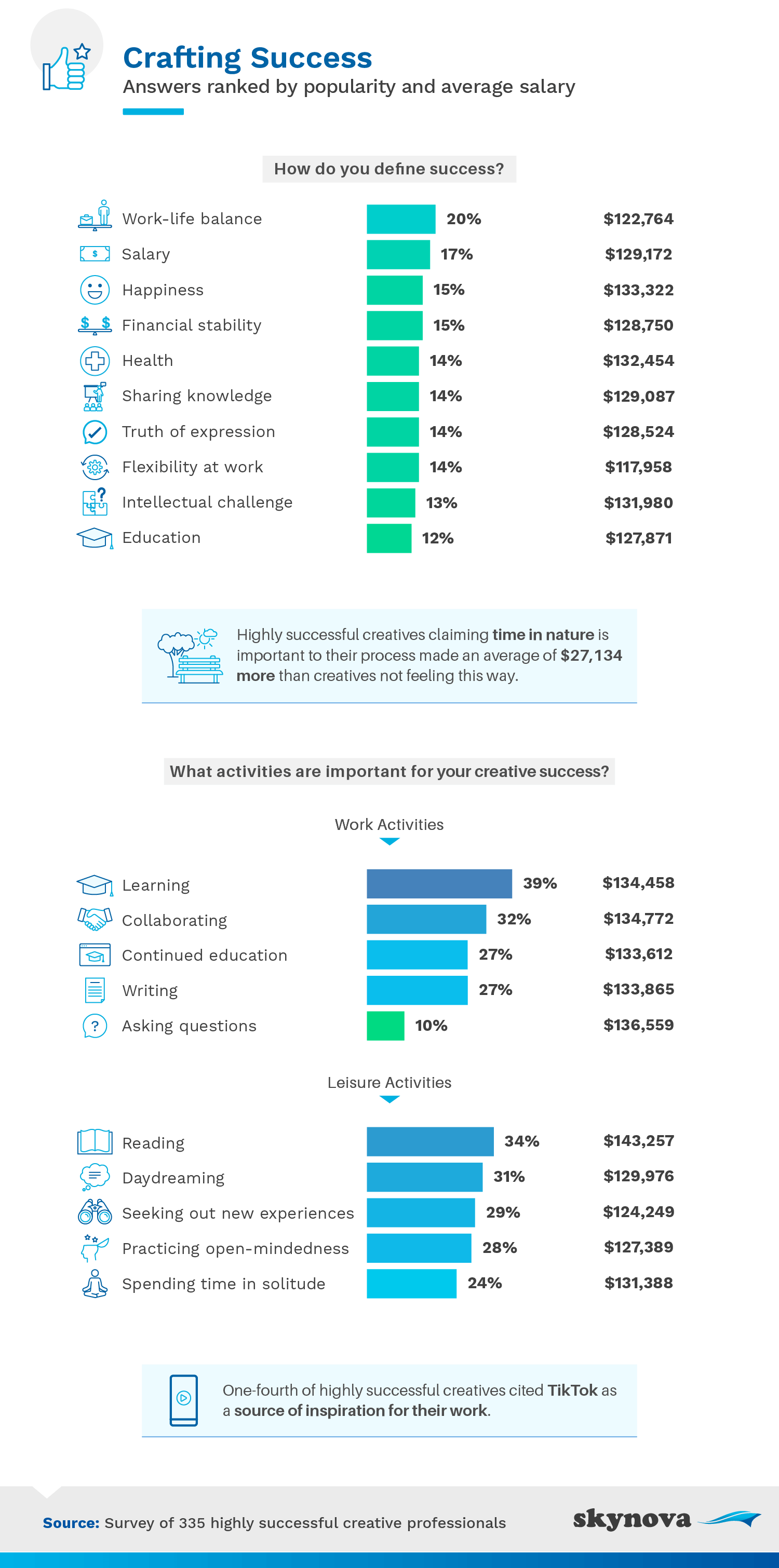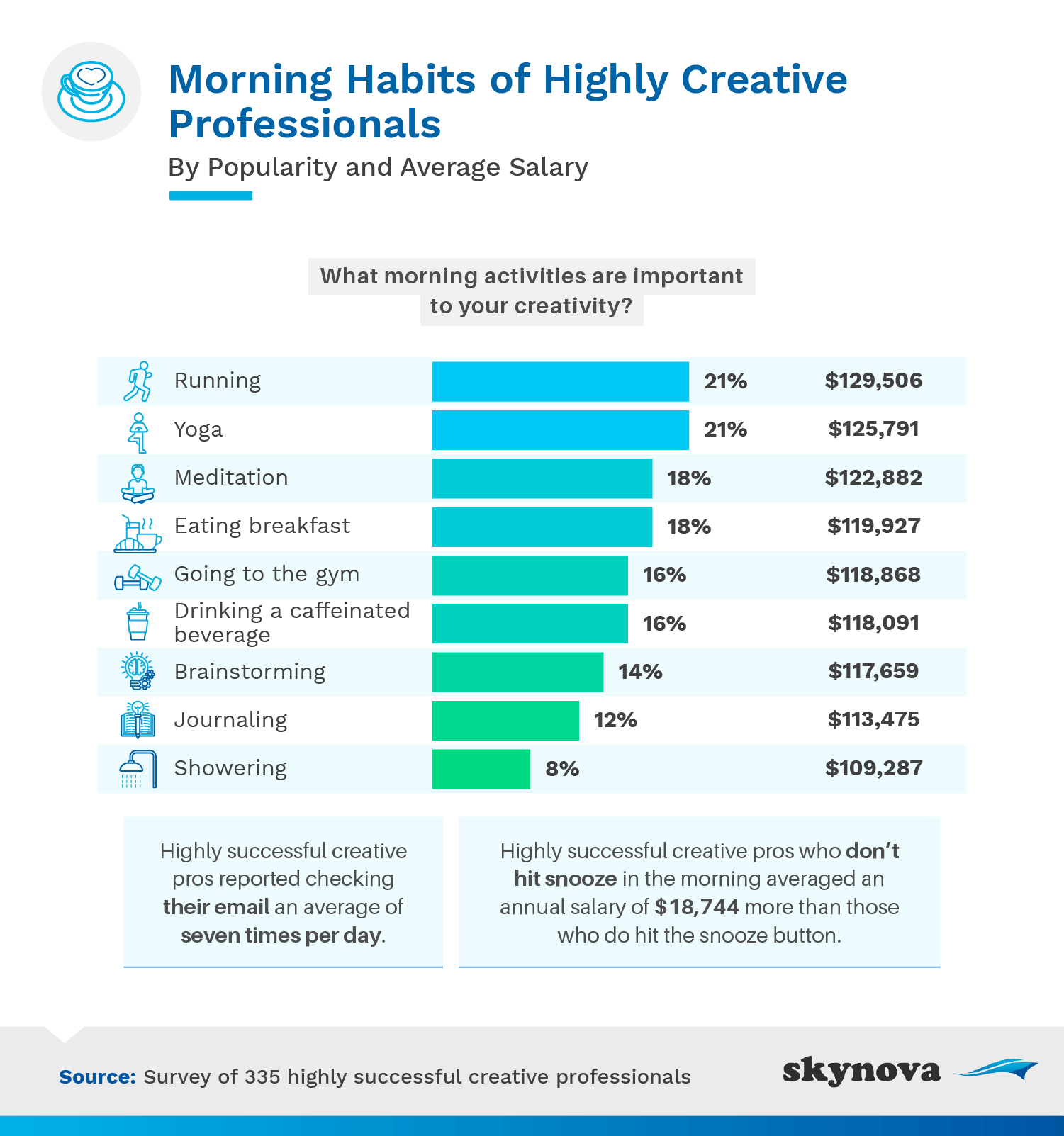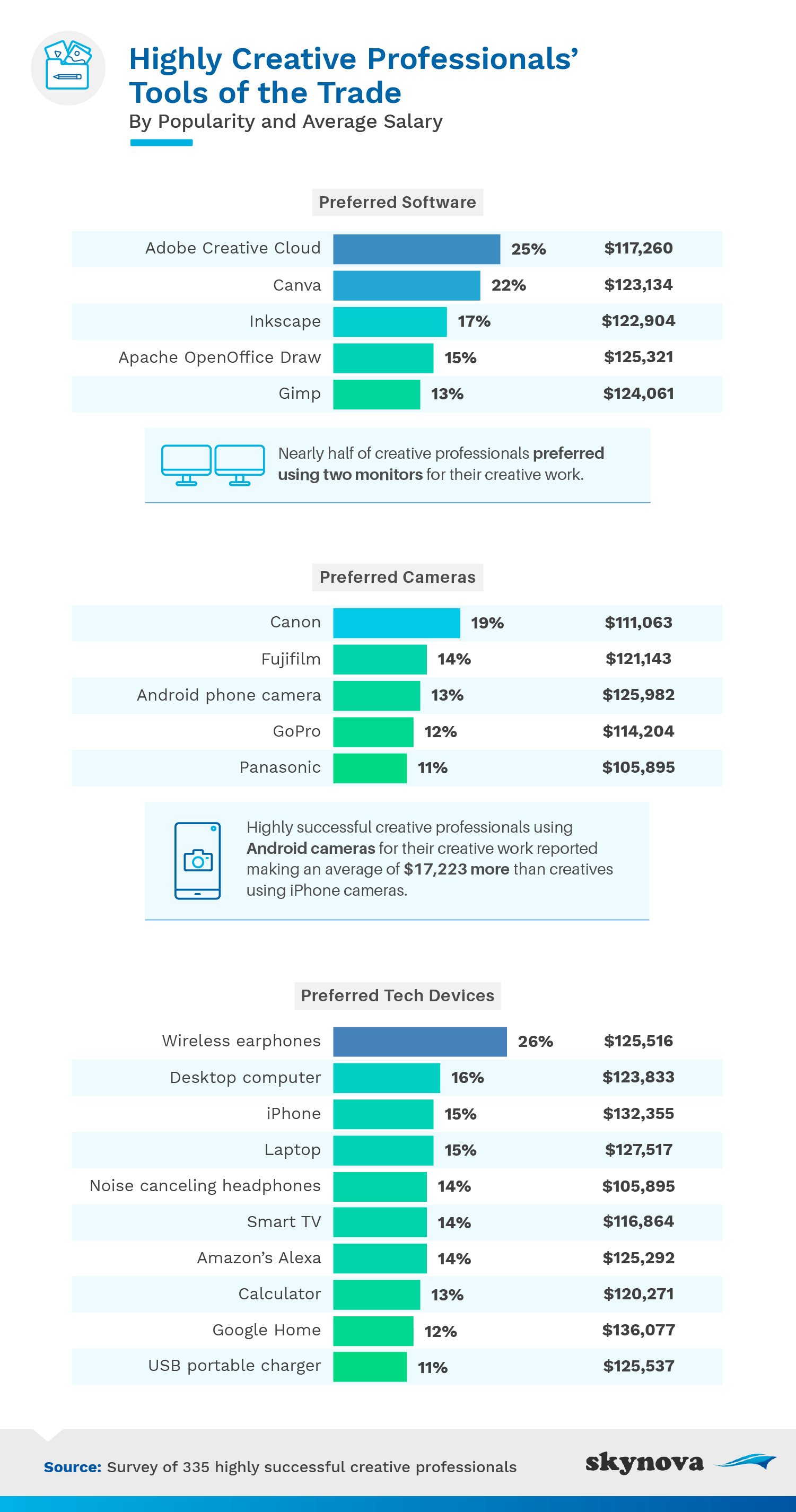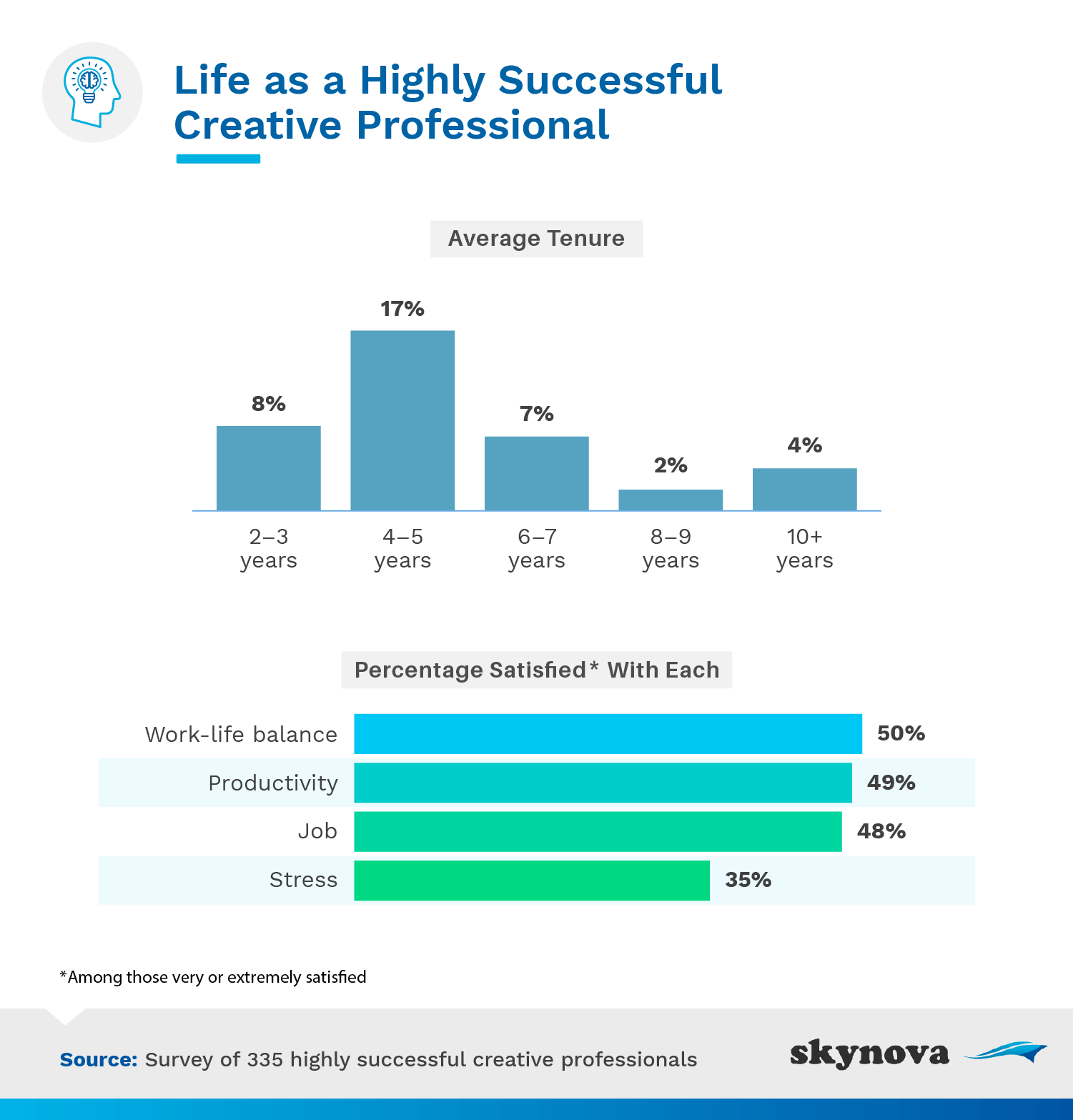
|
Creativity generates big ideas that lead to great success for highly creative people in the workforce, but imagination and inspiration don't just belong in artistic professions. Professionals across many different industries need creativity to spark original ideas, make connections, and solve problems.
We've seen how creativity changes the world, so, unsurprisingly, it has often been studied by neuroscientists seeking to understand how the brain produces creative thoughts. Scientific research backs four types of creativity in which our minds can engage, yet we were still curious to know if people's regular habits could also affect their creative process. We decided to embark on a project to understand how people stay creative and find success.
We surveyed more than 335 creative professionals to explore their work and lifestyle habits, including their activities and tools for success.
Our study began by asking a pool of highly creative professionals, such as graphic designers, artists, and architects, to define what success means to them. Inquiring minds also wanted to know how creatives regularly find inspiration that leads to success in their careers.

How a person defines success in their career doesn't always focus on fame and fortune. Happiness was the main definition of success among the highest-earning creative professionals we surveyed.
Being in good health and feeling intellectually challenged were two additional top indicators of success for those with an average annual salary greater than $130,000. Psychologists have debated whether success creates happiness or if happiness creates success. Past studies suggest that happiness must come first. According to these studies, happier people have more positive moods that help motivate them to work toward new goals and build new resources. Happiness leads to increased confidence, optimism, and energy that other people find attractive and engaging. These studies also found that happier individuals are more likely than their less happy peers to experience the following:
Reading, learning, and seeking new experiences were also highly valued by the best-paid creatives and seen as a vital part of inspiring their creative process. We also found it interesting that 25% of very successful creatives turned to TikTok as a main source of inspiration. Our findings suggest that some creatives see TikTok as a space that sparks creative inspiration and happiness.
Exploring the great outdoors was another popular activity reported to help creative minds do what they do best. In fact, we found that people who reported spending time in nature made an average of $27,134 more than creatives who didn't prioritize outdoor activity. The American Psychological Association (APA) recently reported on research about the positive effects of nature on our minds. Researchers concluded that spending time outdoors leads to the following positives:
Feeling connected to nature increases happiness and perks up a tired mind, even in green spaces in urban environments. Researchers also found that it doesn't matter how much time you have to spend in nature, that any small amount—even 40 seconds—has proven to be mentally beneficial.
We examined highly creative professionals' morning routines and regular work habits to see if we could uncover the secrets to their success. Here's what we discovered.

Big ideas often equal big pay among creative professionals with successful careers. The professionals we surveyed reported earning six-figure incomes before taxes, with salaries ranging from $100,000 to $130,000 or more. The average annual salary increase for highly successful creatives (who earned a raise or promotion within the past year) was $14,082.
Making physical and mental health a daily priority impacts a person's happiness and success. Studies have shown that walking and running boost creativity during physical activity and shortly after. Running, yoga, and meditation were the top three regular morning activities linked to optimal productivity and higher salaries among successful creative professionals. Spending extra time on the job also appeared to play a part in their success, as nearly 1 in 4 highly successful creative professionals worked more than 40 hours per week.
Our study results also suggest that a simple morning routine change may pay off in the long run. We discovered that highly successful creative professionals who don't hit the snooze button in the morning earn about $18,744 more annually than those hitting snooze. Long-term use of a snooze button interrupts sleep cycles which heightens stress and inflammation and leads to cognitive decline. Restful sleep and a physically and/or mentally active morning routine appear to be essential for the most creative minds.

Highly creative people use various tools during the creative process. Below are the top tools of the trade, according to our research. Interestingly, people who used Android cameras for their creative work earned thousands of dollars more than iPhone camera users.

Canon was the most popular camera brand among creatives, but top earners used Android phone cameras more often for work than any other brand. Professionals who used Android phone cameras reported making an average of $17,223 more per year than those relying on iPhone cameras for their creative work.
The software collection Adobe Creative Cloud was highly popular among respondents: 25% of creatives said Adobe software was important to their creative processes. We observed that Adobe Creative Cloud software was used most among the lowest wage earners. The highest-paid professionals preferred Apache OpenOffice Draw for their creative needs.
Stress management is a big issue among the successful and highly creative crowd. It may be one reason why there's high turnover in creative job positions.

Creative burnout is real, and stress is one of the main causes. The APA suggests people take these seven steps to help cope with work stress.
The most successful creatives defined their success in terms of how happy and healthy they felt in their minds and bodies. They often turned to reading, nature, and social media for rejuvenation and inspiration. The morning habits of the highest-paid creatives included running, yoga, or meditation. Caring for the mind and body reduces stress, releases happy hormones, and promotes a clear mind and overall sense of well-being. We conclude that healthy habits support creativity and success in the workplace.
Skynova online software helps small businesses simplify and speed up billing processes. We hope you found this piece about the habits of highly creative people interesting. Our articles are based on statistics gathered through surveys and online research to bring new insights to current topics about business, the workplace, technology, and more.
We surveyed 335 creative professionals making at least $70,000 to explore their life, habits, and tools for success. The mean age of respondents was 36 years old. 58% were men, 41% were women, and 1% identified as nonbinary. Respondents were composed of the following generational breakdown: 20% Generation Z, 50% millennials, 21% Generation X, and 9% baby boomers.
To help ensure that all respondents took our survey seriously, they were required to identify and correctly answer an attention-check question. Survey data has certain limitations related to self-reporting. These limitations include telescoping, exaggeration, and selective memory.
If your readers are looking for ways to be more successful in a creative field, we encourage you to share the results of this study for any noncommercial use. When doing so, please include a link back to this page in your article so they will have access to all of our findings and methodology.